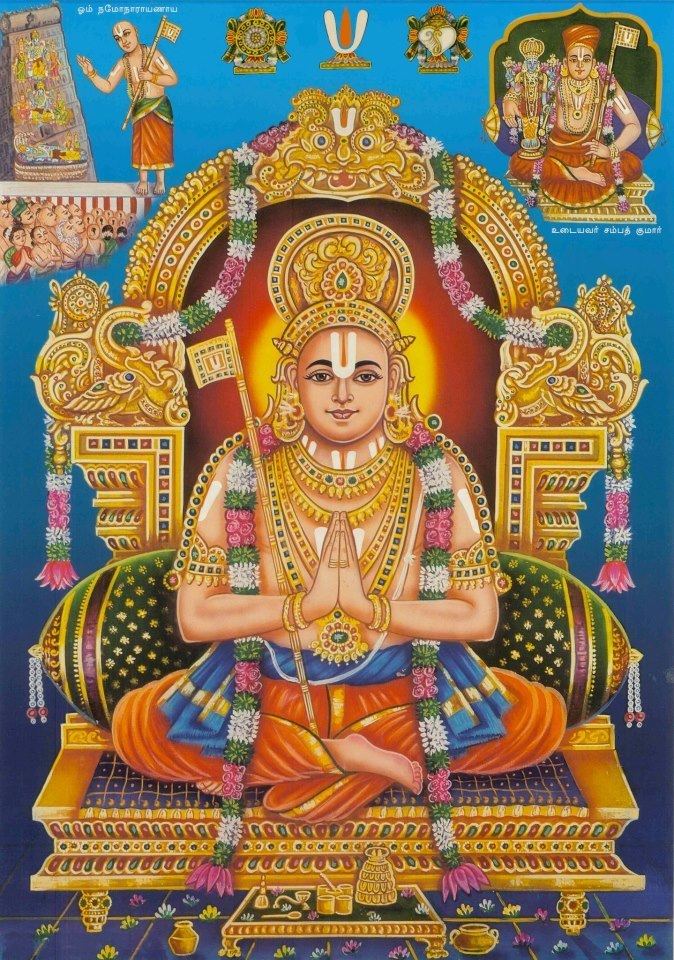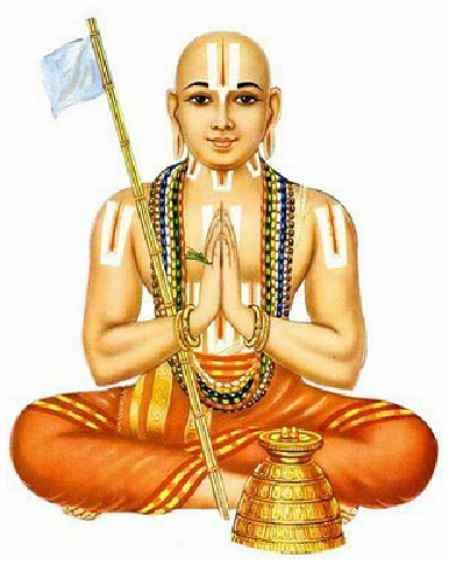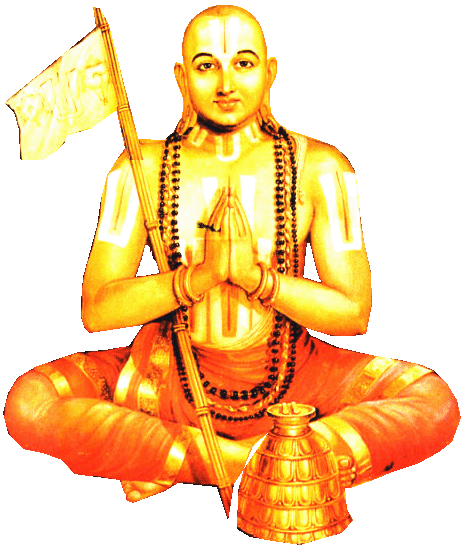Books Bhavartha Ratnakara | Name Ramanuja Ramanuja Role Philosopher | |
 | ||
Titles/honours Emberumaar, Udayavar, Yathiraja, Most venerated acharya (teacher) in the philosophy of Sri Vaishnavism. Literary works Vedartha Sangraham, Sri Bhashyam, Gita Bhashyam, Vedanta Deepam, VedAnta Saram, Sharanagati Gadyam, Sriranga Gadyam, Sri Vaikuntha Gadyam, Nitya Grantham Parents Keshava Somaji, Kantimathi Similar People Madhvacharya, Adi Shankara, Srinivasa Ramanujan, J A B van Buitenen Died c. 1137 CE (aged 120) Sri Rangam, Tamil Nadu, India Born c. 1017 CE (age 120),Sriperumbudur, Tamil Nadu, India | ||
Philosophy of sri ramanuja on 15 07 2017 video 1
Ramanuja (traditionally, 1017–1137 CE; IAST: Rāmānuja; [raːmaːnud͡ʑə] ) was a Hindu theologian, philosopher, and one of the most important exponents of the Sri Vaishnavism tradition within Hinduism. He was born in a Tamil Brāhmin family in the village of Sriperumbudur, Tamil Nadu. His philosophical foundations for devotionalism were influential to the Bhakti movement.
Contents
- Philosophy of sri ramanuja on 15 07 2017 video 1
- Ramanuja and his philosophy by swami sarvadevananda
- Biography
- Hagiographies
- Historical background
- Writings
- Philosophy
- Comparison with other Vednta schools
- Influence
- Disciples
- Names
- References

Rāmānuja's guru was Yādava Prakāśa, a scholar who was a part of the more ancient Advaita Vedānta monastic tradition. Sri Vaishnava tradition holds that Rāmānuja disagreed with his guru and the non-dualistic Advaita Vedānta, and instead followed in the footsteps of Indian Alvārs tradition, the scholars Nāthamuni and Yamunāchārya. Rāmānuja is famous as the chief proponent of Vishishtadvaita subschool of Vedānta, and his disciples were likely authors of texts such as the Shatyayaniya Upanishad. Rāmānuja himself wrote influential texts, such as bhāsya on the Brahma Sutras and the Bhagavad Gita, all in Sanskrit.

His Vishishtadvaita (qualified monism) philosophy has competed with the Dvaita (theistic dualism) philosophy of Madhvāchārya, and Advaita (monism) philosophy of Ādi Shankara, together the three most influential Vedantic philosophies of the 2nd millennium. Rāmānuja presented the epistemic and soteriological importance of bhakti, or the devotion to a personal God (Vishnu in Rāmānuja's case) as a means to spiritual liberation. His theories assert that there exists a plurality and distinction between Ātman (soul) and Brahman (metaphysical, ultimate reality), while he also affirmed that there is unity of all souls and that the individual soul has the potential to realize identity with the Brahman.

Ramanuja and his philosophy by swami sarvadevananda
Biography
The details of historic Rāmānuja (Tamil: இளையாழ்வார்) are unknown. His followers in the Vaishnava tradition wrote hagiographies, some of which were composed in centuries after his death, and which the tradition believes to be true.
The traditional hagiographies of Rāmānuja state he was born in a Brāhmin family, to mother Kānthimathi and father Kesava Somayāji, in Sriperumbudur, near modern Chennai, Tamil Nādu. They place his life in the period of 1017–1137 CE, yielding a lifespan of 120 years. These dates have been questioned by modern scholarship, based on temple records and regional literature of 11th- and 12th-century outside the Sri Vaishnava tradition, and modern era scholars suggest that Rāmānuja may have lived between 1077-1157.
Rāmānuja married, moved to Kānchipuram, studied in an Advaita Vedānta monastery with Yādava Prakāśa as his guru. Rāmānuja and his guru frequently disagreed in interpreting Vedic texts, particularly the Upanishads. Rāmānuja and Yādava Prakāśa separated, and thereafter Rāmānuja continued his studies on his own.
He attempted to meet another famed Vedanta scholar of 11th-century Yamunāchārya, but Sri Vaishnava tradition holds that the latter died before the meeting and they never met. However, some hagiographies assert that the corpse of Yamunāchārya miraculously rose and named Rāmānuja as the new leader of Sri Vaishnava sect previously led by Yamunāchārya. One hagiography states that after leaving Yādava Prakāśa, Rāmānuja was initiated into Sri Vaishnavism by Periya Nambi, also called Māhapurna, another Vedānta scholar. Rāmānuja renounced his married life, and became a Hindu monk. However, states Katherine Young, the historical evidence on whether Rāmānuja led a married life or he did renounce and became a monk is uncertain.
Rāmānuja became a priest at the Varadharāja Perumal temple (Vishnu) at Kānchipuram, where he began to teach that moksha (liberation and release from samsara) is to be achieved not with metaphysical, nirguna Brahman but with the help of personal god and saguna Vishnu.Rāmānuja has long enjoyed foremost authority in the Sri Vaishnava tradition.
Hagiographies
A number of traditional biographies of Rāmānuja are known, some written in 12th century, but some written centuries later such as the 17th or 18th century, particularly after the split of the Śrīvaiṣṇava community into the Vadakalais and Teṉkalais, where each community created its own version of Rāmānuja's hagiography. The Muvāyirappaṭi Guruparamparāprabhāva by Brahmatantra Svatantra Jīyar represents the earliest Vadakalai biography, and reflects the Vadakalai view of the succession following Rāmānuja. Ārāyirappaṭi Guruparamparāprabhāva, on the other hand, represents the Tenkalai biography. Other late biographies include the Yatirajavaibhavam by Andhrapurna.
Modern scholarship has questioned the reliability of these hagiographies. Scholars question their reliability because of claims which are impossible to verify, or whose historical basis is difficult to trace with claims such as Rāmānuja learned the Vedas when he was an eight-day-old baby, he communicated with God as an adult, that he won philosophical debates with Buddhists, Advaitins and others because of supernatural means such as turning himself into "his divine self Sesha" to defeat the Buddhists, or God appearing in his dream when he prayed for arguments to answer Advaita scholars. According to J. A. B. van Buitenen, the hagiographies are "legendary biographies about him, in which a pious imagination has embroidered historical details".
Historical background
Rāmānuja grew up in the Tamil culture, in a stable society during the rule of the Hindu Cholas dynasty. This period was one of pluralistic beliefs, where Vaishnava, Shaiva, Smarta traditions, Buddhism and Jainism thrived together. In Hindu monastic tradition, Advaita Vedānta had been dominant, and Rāmānuja's guru Yādava Prākāsha belonged to this tradition. Prior to Rāmānuja, the Sri Vaishnava sampradaya was already an established organization under Yamunāchārya, and bhakti songs and devotional ideas already a part of south Indian culture because of the twelve Alvārs. Rāmānuja's fame grew because he was considered the first thinker in centuries that disputed Shankara's theories, and offered an alternate interpretation of Upanishadic scriptures.
Some hagiographies, composed centuries after Rāmānuja's death, state that he was expelled by a Chola king, Kulottunga II, Rāmānuja then moved to another kingdom for 12 years, converted a Jain king to Hinduism after miraculously healing his daughter, and later returned on his own to Tamil Nādu. However, verifiable historical evidence for these legends have been lacking, and epigraphical evidence establishes that Kulottunga II came to power in 1133 CE, while Rāmānuja died in 1137 CE according to sources that claim Rāmānuja was expelled. According to John Carman, Rāmānuja and his Srīvaiṣṇava disciples lived under the relatively stable and non-sectarian climate of the Chola empire, before its decline in the late 12th and 13th centuries.
Writings
The Sri Vaisnava tradition attributes nine Sanskrit texts to Rāmānuja – Vedārthasangraha (literally, "Summary of the Vedas meaning"), Sri Bhāshya (a review and commentary on the Brahma Sutras), Bhagavad Gita Bhāshya (a review and commentary on the Bhagavad Gita), and the minor works titled Vedāntapida, Vedāntasāra, Gadya Trayam (which is a compilation of three texts called the Saranāgati Gadyam, Sriranga Gadyam and the Srivaikunta Gadyam), and Nitya Grantham.
Some modern scholars have questioned the authenticity of all but the three of the largest works credited to Rāmānuja – Shri Bhāshya, Vedārthasangraha and the Bhagavad Gita Bhāshya.
Philosophy
Rāmānuja's philosophical foundation was qualified monism, and is called Vishishtadvaita in the Hindu tradition. His ideas are one of three subschools in Vedānta, the other two are known as Ādi Shankara's Advaita (absolute monism) and Madhvāchārya's Dvaita (dualism).
Rāmānuja accepted that the Vedas are a reliable source of knowledge, then critiqued other schools of Hindu philosophy, including Advaita Vedānta, as having failed in interpreting all of the Vedic texts. He asserted, in his Sri Bhāshya, that purvapaksin (previous schools) selectively interpret those Upanishadic passages that support their monistic interpretation, and ignore those passages that support the pluralism interpretation. There is no reason, stated Rāmānuja, to prefer one part of a scripture and not other, the whole of the scripture must be considered on par. One cannot, according to Rāmānuja, attempt to give interpretations of isolated portions of any scripture. Rather, the scripture must be considered one integrated corpus, expressing a consistent doctrine. The Vedic literature, asserted Rāmānuja, mention both plurality and oneness, therefore the truth must incorporate pluralism and monism, or qualified monism.
This method of scripture interpretation distinguishes Rāmānuja from Ādi Shankara. Shankara's exegetical approach Samanvayat Tatparya Linga with Anvaya-Vyatireka, states that for proper understanding all texts must be examined in their entirety and then their intent established by six characteristics, which includes studying what is stated by the author to be his goal, what he repeats in his explanation, then what he states as conclusion and whether it can be epistemically verified. Not everything in any text, states Shankara, has equal weight and some ideas are the essence of any expert's textual testimony. This philosophical difference in scriptural studies, helped Shankara conclude that the Principal Upanishads primarily teach monism with teachings such as Tat tvam asi, while helping Rāmānuja conclude that qualified monism is at the foundation of Hindu spirituality.
Comparison with other Vedānta schools
Rāmānuja's Vishishtadvaita shares the theistic devotionalism ideas with Madhvāchārya's Dvaita. Both schools assert that Jīva (human souls) and Brahman (as Vishnu) are different, a difference that is never transcended. God Vishnu alone is independent, all other gods and beings are dependent on Him, according to both Madhvāchārya and Rāmānuja. However, in contrast to Madhvāchārya's views, Rāmānuja asserts "qualified non-dualism", that souls share the same essential nature of Brahman, and that there is a universal sameness in the quality and degree of bliss possible for human souls, and every soul can reach the bliss state of God Himself. While the 13th- to 14th-century Madhavāchārya asserted both "qualitative and quantitative pluralism of souls", Rāmānuja asserted "qualitative monism and quantitative pluralism of souls", states Sharma.
Rāmānuja's Vishishtadvaita school and Shankara's Advaita school are both nondualism Vedānta schools, both are premised on the assumption that all souls can hope for and achieve the state of blissful liberation; in contrast, Madhvāchārya believed that some souls are eternally doomed and damned. Shankara's theory posits that only Brahman and causes are metaphysical unchanging reality, while the empirical world (Maya) and observed effects are changing, illusive and of relative existence. Spiritual liberation to Shankara is the full comprehension and realization of oneness of one's unchanging Ātman (soul) as the same as Ātman in everyone else as well as being identical to the nirguna Brahman. In contrast, Rāmānuja's theory posits both Brahman and the world of matter are two different absolutes, both metaphysically real, neither should be called false or illusive, and saguna Brahman with attributes is also real. God, like man, states Rāmānuja, has both soul and body, and all of the world of matter is the glory of God's body. The path to Brahman (Vishnu), asserted Rāmānuja, is devotion to godliness and constant remembrance of the beauty and love of personal god (saguna Brahman, Vishnu), one which ultimately leads one to the oneness with nirguna Brahman.
Influence
Harold Coward describes Rāmānuja as "the founding interpreter of Sri Vaisnavite scripture." Wendy Doniger calls him "probably the single most influential thinker of devotional Hinduism". J. A. B. van Buitenen states Rāmānuja was highly influential, by giving "bhakti an intellectual basis", and his efforts made bhakti the major force within different traditions within Hinduism.
Modern scholars have compared the importance of Rāmānuja in Hinduism to that of scholar Thomas Aquinas (1225–1274) in Christianity.
Rāmānuja reformed the Srirangam Ranganathaswamy Temple complex, undertook India-wide tours and expanded the reach of his organization. The temple organization became the stronghold of his ideas and his disciples. It is here that he wrote his influential Vishishtadvaita philosophy text, Sri Bhashyam, over a period of time.
Rāmānuja not only developed theories and published philosophical works, he organized a network of temples for Vishnu-Lakshmi worship. Rāmānuja set up centers of studies for his philosophy during the 11th- and 12th-century, by traveling through India in that era, and these influenced generations of poet saints devoted to the Bhakti movement. Regional traditions assert that his visits, debates and discourses triggered conversion of Jains and Buddhists to Vaishnavism in Mysore and Deccan region.
The birthplace of Rāmānuja near Chennai hosts a temple and is an active Vishishtadvaita school. His doctrines inspire a lively intellectual tradition in southern, northern and eastern states of India, his monastery and temple traditions are carried on in the most important and large Vaishnava centres – the Ranganātha temple in Srirangam, Tamil Nadu, and the Venkateswara Temple, Tirumala in Tirupati, Andhra Pradesh.
Disciples
Names
He is also known as Śrī Rāmānujāchārya, Udaiyavar, Ethirājar (Yatirāja, king of monks), Bhashyakarar, Godāgrajar, Thiruppavai Jeeyar, Emberumānār and Lakshmana Muni
